Published
on 12
Feb 2020
|
All rights reserved.
|
|

|
|
Honda
is late to the EV party. It tries to catch attention with a niche city
car.
|
|
Over the last 2 decades,
Honda has been ignoring the potential of electric cars as it gambled on
hydrogen fuel cell technology. It invested too much money and time into
the FCX Clarity and the current Clarity, failing to catch the EV boom
pioneered by Tesla. When it wakes up, it is already late to the party.
While other manufacturers have ambitious plans for
mass-producing electric cars, Honda is still testing the water with a
low-volume
experiment. Called simply E, it is built in Japan and sold exclusively
in Europe. Honda said it expects to sell 2000 cars in the UK this year,
so for the whole Europe I suppose the total will not be much over
10,000 cars. Still, it should help the firm to meet the CO2
fleet
average limit of 95 g/km to be effective in EU this year.
As it is not exactly mass market, Honda follows the footprints of BMW
i3 to position the E as a premium city car. It is small, measuring only
3.9 meters in length, smaller than most superminis. However, it is made
with superior quality and is more generously equipped so that it can be
priced higher. In the UK it costs between £26,000 and
£29,000 after the government’s EV grant of £3500. This
means it is cheaper than the i3 – which is reasonable because the
latter’s carbon-fiber and aluminum construction is worth the extra –
but more than the new Mini Electric (Cooper SE), as well as the
mainstream Peugeot e-208, Opel Corsa-e and the upcoming Volkswagen ID3,
all of which offer larger batteries and longer ranges.
The biggest selling point of E is design. It is deliberately retro,
clearly inspired by the original VW Golf. The boxy body speaks of
1970s. Yet the bug eyes and black face are taken from Honda’s own
N-One. The black face and round lamps are mirrored at its tailgate. As
a whole, this is a very cute and lovely design. Also highly practical.

|
|
The
most remarkable about this car is 5 screens span the full width of the
dashboard.
|
|
Inside, the cabin offers plenty of width and headroom for tall guys up
front, but the rear bench is quite cramped. The ambience is light and
airy,
thanks to large windows, light color wood trims and seat fabrics as
well as an expansive dashboard. While it doesn’t look as futuristic as
BMW i3, the materials and build quality are suitably premium. Most
remarkable is the full-width display that consists of an 8.8-inch
digital instrument reading, two 12.3-inch TFT touchscreens and two LCD
screens for displaying images taken from the rearview cameras which
replace conventional door mirrors. In particular, the extra-wide
infotainment touchscreens are amazing, offering fancy graphics and you
can drag or switch applications between them. With an HDMI port and
230V socket, you can even turn the expansive screens into a theatre
or a game display. Cool. There is also a voice recognition system for
controlling functions of infotainment system, much like what Mercedes
has been offering for some time.
Mechanically (or electrically), the E follows the trend set by Tesla to
place its battery under the floor and within the wheelbase, which is
the natural choice for a
dedicated EV platform. Like i3 but not most other compact EVs, its
single electric motor is mounted at the rear axle and drives the rear
wheels. The inverter and charger are mounted up front, and strangely,
taking all the space under the bonnet. Considering how big the front
end looks, you can’t help feeling disappointed that Honda did not use
the space to create a front trunk (or “frunk”, a term invented by Tesla
boss Elon Musk). This means the only luggage compartment is the space
located above the rear motor. It is quite shallow, measuring only 171
liters with the rear bench in place. This is probably the biggest
weakness of the car.
Unlike most rivals bar i3 and Mini, the car employs all-independent
suspensions. Each corner is suspended by MacPherson struts. Coupling to
rear-wheel drive, 50:50 weight distribution and a low center of
gravity, a good handling is guaranteed. Meanwhile, performance is not
exactly top notch but still easily stronger than a regular petrol
supermini. Its motor produces either 136 hp or 154 hp, while both
models provide the same peak torque of 232 lbft, enabling very strong
off-the-line acceleration and passing ability until it approaches the
90 mph top speed. 0-60 mph takes less than 8 seconds for the higher
power model, and it feels
stronger still in the real world.
 |
|
With
a high price tag and a small battery, the E seems more outdated than it
looks.
|
|
The E is a great city car as it is compact and has an outstanding
turning radius of 4.3m, thanks to the lack of front engine. Its
suspensions are set quite soft to promote a premium ride quality.
Rolling refinement on highway is remarkable for a supermini, with low
level of wind and road noise, and absolutely no engine noise, of
course.
When the turn gets twisty, the E still controls its 1500kg-plus weight
remarkably well. Body roll is limited, as is understeer. The steering
has a pleasing weight. The brake pedal is well modulated, which is a
rare success in the EV field. That said, it feels well controlled and
refined rather than sporty. The combination of soft suspension and the
extra weight means it is no hot hatch in response and interaction.
Moreover, despite rear-drive, it lacks the power and the necessary
chassis tuning to induce oversteer. A Mini Electric has a stiffer ride
but feels sportier, faster in bend and more engaging to drive. The
Honda has no interest to rival Mini in this respect.
The biggest problem is battery. To cut cost and weight, the Honda E
employs a liquid-cooled battery with just 35.5 kWh of energy. This
gives a dismal WLTP range of 210 km (131 miles), or 222 km (137 miles)
when equipped with smaller 16-inch wheels. Except Mini, all other
rivals offer much larger battery options hence much longer ranges – BMW
i3 (37.9 kWh / 285 km), Nissan Leaf (62 kWh / 385 km), Renault Zoe (52
kWh / 386 km), Peugeot e-208 (50 kWh / 340 km), Opel Corsa-e (50 kWh /
330 km) and VW ID3 (45, 58 and 77 kWh / 330, 420 and 550 km).
Admittedly, some of these larger battery options cost more than the
Honda, but the latter is undeniably overpriced for the battery it
offers. Such a small battery limits the usage of E in urban area. It is
fine for daily commute, but a weekend intercity or cross-country trip
is out of the question. This seriously limits the appeal of the car.
That is why Honda markets it as a niche city car. It might be a good
idea a few years ago, but now the market is shifting quickly towards
mass production EVs that are competitive with conventional ICE cars for
cost and practicality. The Honda E seems more outdated than it looks.
|
Verdict:    |
|